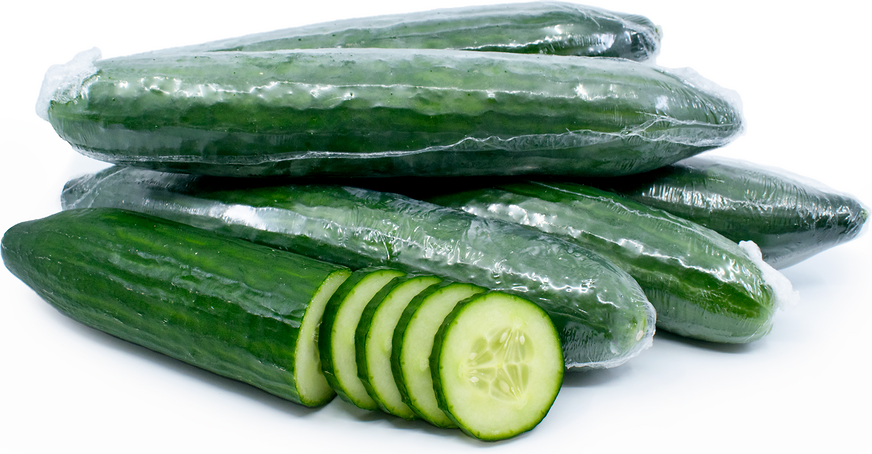


Hot House Cucumbers
Estimated Inventory, 16 ct : 0
Description/Taste
Hot House cucumbers are elongated vegetables that can reach lengths of about 25.5 to 38 centimeters and 2.5 to 5 centimeters in width. They have a thin, cylindrical shape that is rounded at one end and slightly pointed at the other. This variety has dark green, uniformly colored skin with ridges running the length of the vegetable, creating a bumpy, ribbed texture. Their skin is thin enough to be eaten and does not need to be peeled. Hot House cucumbers have a pale green, succulent flesh with a mild, crisp texture. When sliced crosswise, each cucumber slice forms a circle with firm outer flesh surrounding a more tender, juicy interior that contains small, underdeveloped, non-bitter seeds. Hot House cucumbers have a mild, sweet flavor that is much less bitter than common cucumbers.
Seasons/Availability
Hot House cucumbers are available year-round.
Current Facts
Hot House cucumbers are botanically classified as Cucumis sativus and belong to the Cucurbitaceae family, which also includes melons, squashes, and gourds. Also known as English cucumbers or European cucumbers, Hot House cucumbers are classified as burpless, meaning they have thinner skins, a sweeter taste, and are believed to be easier to digest than other types of cucumbers. There are over 100 different cucumber varieties, 4 of the most common being English, Persian, Slicing, and Kirby cucumbers. Slicing cucumbers tend to have smoother, darker, and thicker skin, Persian cucumbers are about half the size of Hot House, and Kirby cucumbers are even smaller, primarily used for pickling.
Nutritional Value
Like all cucumber varieties, Hot House cucumbers are a significant source of vitamin K, which is essential for blood clotting and bone health, helping to prevent fractures and maintain bone density. They also provide vitamin C, an antioxidant that strengthens the immune system, promotes skin health, and aids in tissue repair, while also enhancing iron absorption. Potassium, another key nutrient found in Hot House cucumbers, plays a vital role in maintaining proper fluid balance, regulating blood pressure, and supporting muscle and nerve function, all of which contribute to heart health. Though in smaller amounts, Hot House cucumbers also contain magnesium and manganese, supporting energy production, nerve function, blood sugar regulation, bone formation, metabolism, and inflammation reduction.
Applications
Hot House cucumbers can be used in both raw and cooked applications when sliced lengthwise, widthwise, diced, or julienned. They may be grilled, puréed, pickled, or briefly cooked into soups. Hot House cucumbers are commonly added to salads alongside mixed greens, kale, or arugula and paired with creamy dressings. Their unique texture bodes well for pasta salads, sandwiches, dips, and sushi. They are commonly used in Middle Eastern dishes like falafels, where they are chopped with dill and Greek yogurt and spread on a pita wrap. Complementary ingredients include shellfish, lamb, beef, chilies, tomatoes, mint, oregano, garlic, cumin, chicken, pork, and fresh cheeses like feta and ricotta. Hot House cucumbers will keep for up to a week when stored in the refrigerator.
Ethnic/Cultural Info
The ancient Romans were innovative in their agricultural practices, using early forms of hothouses, or greenhouses, to cultivate cucumbers year-round. Cucumbers, being a warm-season crop, require specific growing conditions, including abundant sunlight and warm temperatures, making it difficult to grow them in cooler climates or during the off-season. To overcome this, the Romans created artificial environments that mimicked these ideal growing conditions. By constructing hothouses made from frames covered with transparent materials to trap heat, they extended the growing season and produced cucumbers even during winter and early spring when they would typically be unavailable as a field crop. This innovation allowed them to grow cucumbers in non-native regions, like ancient Rome, where the Mediterranean climate did not naturally support cucumber cultivation year-round. The ability to simulate warm weather conditions in hothouses gave the Romans an agricultural advantage, allowing them to enjoy fresh cucumbers beyond the traditional growing season and making them pioneers in early greenhouse farming techniques.
Geography/History
Hot House cucumbers are a descent of the cucumber species, which is native to Central Asia and has been cultivated for over 3,000 years. This species spread to Europe and reached England in the 14th century, where it grew in popularity over the next three centuries, eventually leading to the development of varieties like Hot House cucumbers. This variety thrives in temperate to warm climates and high sun exposure, but like its namesake, is often grown in greenhouses to ensure year-round cultivation and protection from frost, which can hinder its growth. Hot House cucumbers are a cultivated variety that is not found in the wild but is often sown in home gardens and produced commercially. They are a popular variety worldwide that’s often found at farmers’ markets and specialty stores.
Recipe Ideas
Recipes that include Hot House Cucumbers. One




